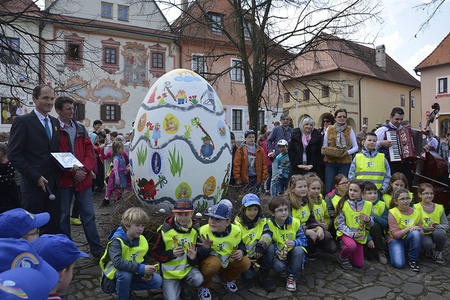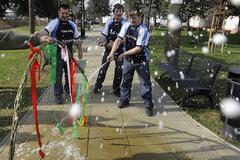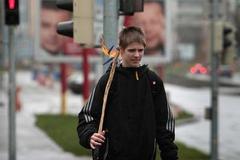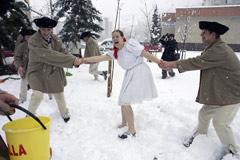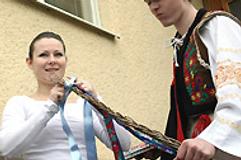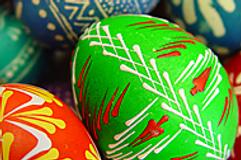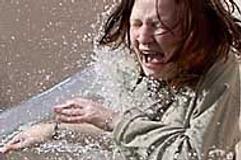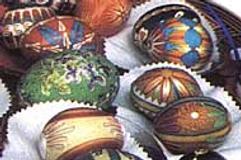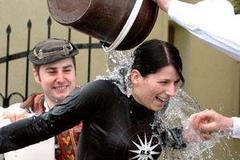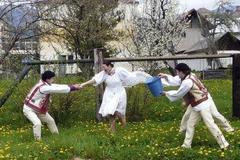Easter, page 3
Easter traditions and events in Slovakia
Easter celebrated traditionally, by re-enactment or by record
EASTER is quite a popular and well-observed holiday in Slovakia, but ways to stress its importance, or to share its message with others, can vary a great deal.
Slovak Post issues an Easter stamp with eucalyptus fragrance
SLOVAK post already prepares for the celebration of Easter, preparing a special stamp, first-day cover (FDC) with an FDC stamp containing the festive motif. It will be enriched in the eucalyptus fragrance. The motif will be the work of influential Slovak visual artist Karol Ondreička called “The Head of Christ” from 1940.
Four brothers weave a record ‘korbáč’
SHORTLY before Easter, four brothers from Horovce broke the record for the longest korbáč, the whip woven from willow branches that is used by Slovak boys and men to ceremonially whip girls and women in their family and neighbourhood in an Easter Monday tradition.
Traditions of a Slovak Easter
THE MEANING of Easter is to commemorate the suffering and death of Jesus Christ and to celebrate his resurrection, the Roman Catholic Archbishop of Bratislava, Stanislav Zvolenský, told the TASR newswire on Good Friday. For Evangelical Christians, Good Friday is a also an important holiday which provides a vivid picture of the nadir of the suffering of Jesus, said the general bishop of the Evangelical Church in Slovakia, Miloš Klátik.
Šibačka
IF THERE is a Slovak custom which is guaranteed to give a translator a headache, it’s the šibačka. What do you call it when a bunch of guys take their whips made of twigs (korbáče), and go door-to-door beating-up ladies, and then getting coloured blown-out eggs (kraslice) in return?
A flirtatious Easter of water and whipping
MY first Easter Monday in Slovakia started with the sound of my boyfriend laughing, just before he startled me out of my peaceful slumber (spánok) by splashing cold water into my face.
A whip and a splash: men and women's views on Easter Monday
SINCE TIME IMMEMORIAL, Easter Monday in Slovakia has been associated with a tradition that many abroad find incredible.
Egad, its Easter egg time
DECORATED eggs are a sign that Easter is upon us. They are also a symbol of fertility and new life. In the past, girls used to present decorated eggs to boys after the boys had whipped them with wicker whips and doused them with buckets of water.
Welcoming spring in the past
PREPARATIONS for Easter in Slovakia usually start with spring cleaning and the decoration of budding branches with eggs, coloured ribbons, and small figurines made out of pastry. These are traditions practised by many families around the country, but in the past other, more unusual customs were observed, and a few are still practised today.
Fertile traditions: Slovak Easter egg art
EASTER is one of the few Christian holidays that does not have a fixed date on the Julian calendar. It obeys the lunar calendar, falling on the first Sunday after the full moon, keeping time with the rhythm of nature and pre-Christian traditions.
Whips and water: Easter in Slovakia
Easter morning was always stressful for Jarmila Holková. Her father woke her at 6:00 a.m. by pouring cold water on her face, and for the next six hours, young men would come to her flat, drag her outside, douse her with buckets of water and whip her with wicker sticks.
Culture Shock: Slovak Easter traditions can bother unwilling women
As a native-born Slovak, it never occurred to me that there was anything striking about the way we celebrate one of the biggest of all Christian festivities, Easter. The suspicion that there was something peculiar about some of our customs only came when I was first confronted with the bewildered looks of foreign visitors to our country who obviously could not understand how they had managed to survive. And though these guests did not ask directly, they all seemed to wonder what the point of our ancient practices could possibly be.
- News digest: 350 brown bears to be culled as Slovakia declares emergency
- A diplomat who thrives on building bridges…and making things happen
- Foot-and-mouth outbreak hits major Slovak cattle farm near Austrian and Czech borders Photo
- Flats in Bratislava are getting smaller, otherwise no one would buy them
- We are partners, friends and Allies
- Unique underground museum in Košice reopens, major renovation set for next year Photo
- News digest: Bear suspected of killing man in central Slovakia
- From Mexico to Slovakia – finding a new life Audio
- Foot-and-mouth outbreak hits major Slovak cattle farm near Austrian and Czech borders Photo
- We are partners, friends and Allies
- From Mexico to Slovakia – finding a new life Audio
- News digest: 350 brown bears to be culled as Slovakia declares emergency
- A paper that wasn’t supposed to last
- News digest: Bear suspected of killing man in central Slovakia
- Bratislava satellite town breaks records and keeps expanding
- Flats in Bratislava are getting smaller, otherwise no one would buy them
- Foot-and-mouth outbreak hits major Slovak cattle farm near Austrian and Czech borders Photo
- France and Slovakia: Believing, loving, and working together
- Last Week: As disease spreads, Fico no longer insists on a “different opinion”
- Trading McDonald’s for the front lines
- From Mexico to Slovakia – finding a new life Audio
- News digest: Bear suspected of killing man in central Slovakia
- A paper that wasn’t supposed to last
- Bratislava satellite town breaks records and keeps expanding
- Slovak dad drops everything for son’s NHL debut — even a flight
- Foot-and-mouth outbreak hits major Slovak cattle farm near Austrian and Czech borders Photo
- The Slovak-American who wants the world to witness the quality of Slovak wines
- France and Slovakia: Believing, loving, and working together
- Then … Now
- Dialects: can west understand east?
- Last Week: As disease spreads, Fico no longer insists on a “different opinion”
- Trading McDonald’s for the front lines
- Strange romance: Slovak leaders’ affection for Russia has yo-yoed
- What abides: Giving a shit
- Slovakia’s rising stars are changing what it means to lead
- A diplomat who thrives on building bridges…and making things happen
- Bratislava to get new flats as iconic building awaits reconstruction
- News digest: 350 brown bears to be culled as Slovakia declares emergency
- Unique underground museum in Košice reopens, major renovation set for next year Photo
- Culture minister, Betliar Museum employees blame each other for problems More articles ›

